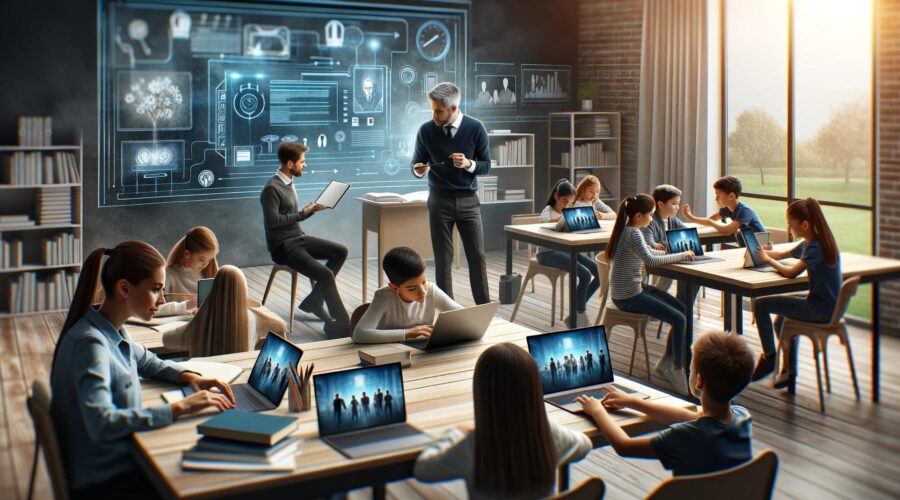The concept of flipped classrooms has been gaining momentum in the educational sphere, fundamentally altering the traditional learning approach. This model reverses the typical lecture and homework elements of a course, where students engage with new material at home, and use classroom time for engaging in practical, collaborative activities. While this innovative approach offers numerous benefits, it also comes with its own set of challenges.
Understanding the Flipped Classroom Model
Before diving into the pros and cons, it’s essential to understand what a flipped classroom entails. In a flipped classroom, students are introduced to the content before class. This introduction can take various forms, such as video lectures, readings, or interactive lessons. The key is that initial learning happens individually and at the student’s pace. Then, classroom time is dedicated to expanding on this knowledge through group discussions, problem-solving exercises, and hands-on projects.
Pros of Flipped Classrooms
Enhanced Student Engagement and Interaction
One of the most significant advantages of flipped classrooms is increased student engagement. With the primary instruction done individually, classroom time becomes a dynamic environment for active learning. Students get more opportunities to discuss, question, and apply concepts, fostering a more interactive and engaging learning experience.
Personalized Learning Experience
Flipped classrooms cater to individual learning paces and styles. Students can pause, rewind, and rewatch lectures, allowing them to learn at their own pace and according to their understanding. This personalized approach helps cater to the needs of both fast and slow learners.
Improved Teacher-Student Interaction
With the basic concepts already covered, teachers can focus more on one-on-one interactions during class time. They can address specific student queries, provide targeted support, and facilitate deeper understanding through discussions and practical exercises.
Development of Critical Thinking and Problem-Solving Skills
As students apply concepts in the classroom through various activities, they develop critical thinking and problem-solving skills. This hands-on approach encourages them to think independently and apply their knowledge in practical situations.
Cons of Flipped Classrooms
Technology Dependency and Accessibility Issues
Flipped classrooms heavily rely on technology for delivering content outside the classroom. This reliance can be a significant barrier for students without access to reliable internet or technological devices, leading to a digital divide and educational inequality.
Increased Workload for Teachers and Students
Developing and organizing materials for flipped classrooms can be time-consuming for teachers. Similarly, students may feel overwhelmed with the expectation to self-learn the material before class, adding to their workload and stress levels.
Potential for Reduced Content Coverage
As more classroom time is dedicated to discussions and activities, there might be a reduction in the amount of content that can be covered compared to traditional lectures. This could potentially lead to gaps in learning or a superficial understanding of complex topics.
Challenges in Student Motivation and Self-Discipline
The success of a flipped classroom heavily depends on the student’s motivation and ability to engage with the material independently. Students lacking self-discipline or motivation may struggle with this model, leading to poor performance and engagement.
Balancing the Pros and Cons
The implementation of the flipped classroom model requires a delicate balance between its advantages and limitations. On the one hand, it offers a more interactive, personalized learning experience, which can significantly enhance student engagement and understanding. Students gain the opportunity to digest information at their own pace and utilize classroom time for deeper exploration and practical application of concepts. This shift can lead to a more dynamic and participatory learning environment where students are more actively involved in their education.
However, the challenges associated with this model cannot be overlooked. The reliance on technology and self-directed learning places a significant responsibility on students, which can be daunting for some. Not all students have equal access to the necessary resources, nor do they all possess the same level of self-motivation and discipline required for successful independent study. Moreover, the increased workload for both teachers and students in preparing and engaging with the material outside of the classroom can be a significant hurdle.
To effectively implement a flipped classroom approach, educators must find a balance. This involves ensuring equitable access to technology, providing support for students who struggle with self-directed learning, and carefully planning classroom activities to maximize the benefits of this model. It’s about adapting the approach to fit the diverse needs of students and recognizing that one size does not fit all in education. The flipped classroom can become a powerful tool in the modern educational landscape with thoughtful implementation and continuous adaptation.
Technology Integration in Flipped Classrooms
The integration of technology is a cornerstone of the flipped classroom model, serving as both a facilitator and a differentiator from traditional educational methods. In this model, technology is a supplementary tool and a primary conduit for delivering instructional content. Digital platforms like educational videos, interactive learning modules, and online discussion forums become the initial touchpoints of learning, replacing the conventional in-class lecture.
This shift necessitates a thoughtful selection of technological tools that are accessible and user-friendly. Videos and online content allow students to engage with the material at their own pace, pausing, rewinding, and reviewing as needed to grasp complex concepts. Furthermore, online quizzes and interactive exercises provide immediate feedback, helping students assess their understanding in real-time. This dynamic approach caters to diverse learning styles and paces, making education more inclusive and personalized.
However, the effective integration of technology in flipped classrooms also brings challenges, such as ensuring all students have equal access to the necessary devices and internet connectivity. Schools and educators must address these digital divide issues to prevent socioeconomic factors from impeding access to learning. Moreover, teachers need to be adept at choosing and utilizing the right digital tools to enhance learning outcomes, requiring ongoing professional development in the ever-evolving landscape of educational technology.
Future Trends and Potential Innovations
The landscape of flipped classrooms is poised for exciting advancements, reflecting the rapid evolution of educational technology and pedagogical approaches. In the near future, we can anticipate several trends and innovations that will further enhance the effectiveness and appeal of this learning model.
One significant trend is the increasing use of artificial intelligence (AI) and machine learning in creating personalized learning experiences. AI-driven platforms could adapt the learning content to match the pace and style of each student, making the flipped classroom even more tailored to individual needs. This could include AI tutors for after-hours help or smart analytics to identify areas where students are struggling, allowing for more targeted in-class activities.
Another area of potential innovation is the integration of virtual and augmented reality (VR/AR) technologies. These tools can transform abstract concepts into immersive, interactive experiences, making learning more engaging and effective. For instance, science students could virtually conduct complex experiments, while history students could explore historical sites in 3D.
Furthermore, the rise of blockchain technology might offer new ways to securely and efficiently manage and track educational records and achievements. This could facilitate a more seamless integration of various educational experiences and credentials.
Finally, there’s a growing emphasis on collaborative and project-based learning in flipped classrooms. Future trends may see more global collaboration projects, where students from different parts of the world work together on projects, facilitated by advanced communication technologies.
These innovations have the potential to not only make flipped classrooms more effective but also to fundamentally change the way we think about education and learning in the 21st century.
Conclusion
The flipped classroom model is a significant shift from traditional teaching methods, bringing both opportunities and challenges. By fostering an interactive, student-centered learning environment, it has the potential to enhance engagement and understanding. However, its effectiveness largely depends on the careful implementation, accessibility, and student motivation. As education continues to evolve, the flipped classroom remains a promising approach, provided its challenges are acknowledged and addressed.

